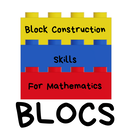Introducing the BLOCS project

LEGO® is a popular and accessible toy which features in many homes and classrooms, and thus the use of Lego in research is met with enthusiasm for both practical and motivational reasons. Research has consistently shown a relationship between children’s block construction skills (using Lego or similar toys) and their maths abilities. That is, children who are good at block construction tend to be good at maths. However, we do not yet know why this is. What are the shared processes that both block construction and maths tap in to? There have also not been any scientific studies of whether it is possible to improve children’s maths ability by training their block construction skills. These questions will be addressed in the BLOCS project, funded by the Leverhulme Trust. BLOCS stands for BLOck Construction Skills for Mathematics. The aims of the BLOCS studies are to provide us with understanding of the impact of Lego play on a range of mathematical skills, to determine whether we can help children to reach their mathematical potential using Lego, and to help children develop the skills needed for careers in Science, Technology, Engineering and Mathematics (STEM) industries.
Is Lego important for maths?
Lego construction involves a composite of spatial skills (including visualisation and visuo-spatial working memory) that are known to be critical to mathematical development. A small number of research studies have explored the relationship between block construction ability (mainly Lego/Duplo) and either spatial ability or maths in children. These studies consistently report a positive relationship between block construction skills and both spatial ability and maths. This consistency is indicative of a reliable relationship. To better understand this relationship, we need to pull apart the component skills which contribute to Lego construction ability and determine which of these skills is also important for maths. For example, the need to rotate a Lego brick in our head to determine how it fits onto the Lego model might be crucial. Or, the ability to keep a diagram of a pre-designed model in mind while focussing on our own model might be key. If we can determine what it is about Lego that is driving the relationship between Lego construction and maths, this has implications for educational practice and interventions designed to improve maths ability.
Does Lego training work?
Only five studies have explored the relationship between spatial training and maths in children and only one incorporated block construction; this study demonstrated a positive impact of a spatial training composite (including block construction, mental imagery, spatial description) on maths in 4-7-year-olds. Block construction training has only been used twice. Whilst the impact on maths was not measured, these studies demonstrated a positive impact on spatial competence in 5-6-year-olds and increased brain activity associated with mental rotation performance in 8-year-olds.
The BLOCS project will fill these research gaps and identify the precise nature of the relationship between block construction and maths skills. We will determine what processes are driving this relationship, and whether the relationship is causal by determining whether training block construction skills (using Lego) has a positive impact on maths ability. We welcome any feedback, particularly regarding teacher or parent experience of Lego clubs or similar as this will help us to design a maximally engaging suite of Lego training sessions. For more information about the BLOCS project and to follow our progress, see the project website: https://www.surrey.ac.uk/block-construction-skills-mathematics-blocs
Written by Emily Farran
